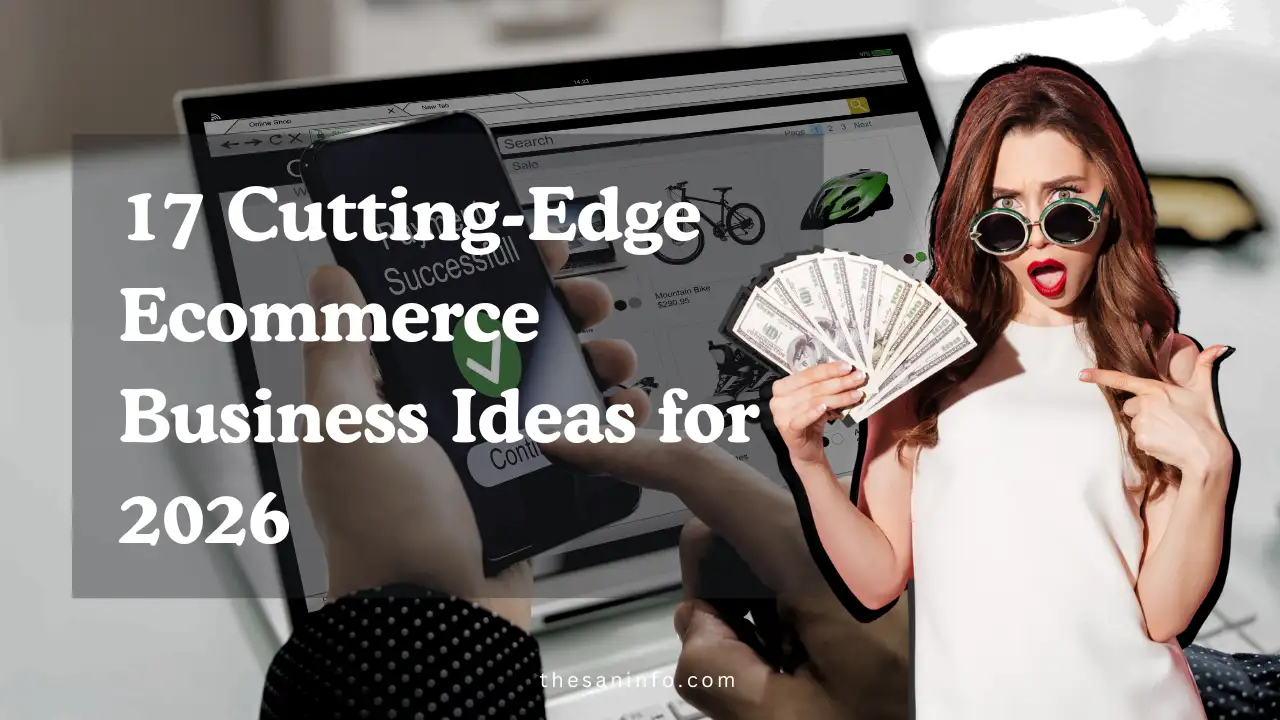17 Cutting-Edge Ecommerce Business Ideas for 2026: Launch Your Online Store Now
The ecommerce landscape in 2026 is poised for explosive growth, with global online sales projected to surpass $7.5 trillion, driven by a 10–12% annual growth rate. Advancements in AI, augmented reality (AR), and blockchain, alongside consumer demand for sustainability and personalization, are creating fertile ground for new ventures. Industry insights highlight that niche ecommerce businesses can thrive with low startup costs—typically $500–$5,000—using platforms like Shopify, WooCommerce, or Etsy. However, competition in popular niches like fashion and the need for sophisticated digital marketing pose challenges. This blog post explores 17 innovative ecommerce business ideas for 2026, drawing from industry trends, expert analyses, and real-world examples to inspire your next venture.
Why Ecommerce in 2026?
Consumer behavior is shifting rapidly—75% of U.S. shoppers now buy online regularly, and mobile commerce accounts for 45% of transactions. Emerging technologies like AI-driven recommendations, AR product previews, and blockchain-based transparency are transforming how businesses connect with customers. While oversaturation in some niches sparks debate, targeting underserved markets or leveraging tech can boost success rates by 20%. These ideas cater to diverse skill sets and budgets, emphasizing trends like sustainability, personalization, and Web3 integration.
17 Ecommerce Business Ideas for 2026
Below is a curated list of ideas, grouped by category, with details on startup costs, potential earnings, and actionable steps. Each aligns with 2026’s key trends: sustainability, tech innovation, and niche targeting.
Sustainable and Ethical Ventures
Sustainability remains a top priority, with 65% of consumers favoring eco-friendly brands by 2026.
- Eco-Conscious Fashion Rentals
Offer rental services for sustainable or designer clothing, appealing to eco-minded and budget-conscious shoppers. The rental market is projected to grow 15% by 2026.
Potential Earnings: $1,500–$12,000/month with a strong catalog.
Startup Costs: $1,000–$5,000 (inventory, platform setup).
How to Start: Source sustainable brands; use platforms like Turo for rentals and promote via Instagram Reels. - Biodegradable Pet Products
Sell eco-friendly pet toys, beds, or compostable waste bags. The pet industry is expected to hit $150 billion globally.
Potential Earnings: $2,000–$20,000/month.
Startup Costs: $500–$2,500 (inventory, Shopify store).
How to Start: Partner with green suppliers; market via pet-focused TikTok accounts. - Upcycled Home Decor
Offer furniture or decor made from recycled materials, like reclaimed wood tables. Upcycling is gaining 20% year-over-year traction.
Potential Earnings: $1,000–$10,000/month.
Startup Costs: $500–$3,000 (materials, website).
How to Start: Source from local salvage yards; sell on Etsy and promote via Pinterest.
Tech-Driven and Personalized Stores
AI and AR are revolutionizing ecommerce, with 30% of retailers adopting these by 2026.
- AI-Curated Wellness Boxes
Deliver personalized supplements, skincare, or self-care kits using AI-driven customer quizzes. Wellness ecommerce is growing 25% annually.
Potential Earnings: $2,000–$25,000/month.
Startup Costs: $1,500–$5,000 (AI tools, inventory).
How to Start: Use platforms like Proven Skincare for AI; advertise on health-focused X accounts. - AR-Enhanced Jewelry Store
Sell jewelry with AR try-on features for virtual fitting. AR adoption in ecommerce is up 20%.
Potential Earnings: $3,000–$20,000/month.
Startup Costs: $2,000–$10,000 (AR tech, inventory).
How to Start: Integrate Shopify AR; market via Instagram Stories. - NFT-Linked Physical Products
Sell collectibles (e.g., art, sneakers) tied to NFTs for authenticity via blockchain. The Web3 market is projected to grow 40% by 2026.
Potential Earnings: $2,000–$50,000/month.
Startup Costs: $1,000–$5,000 (blockchain integration, products).
How to Start: Use OpenSea for NFTs; sell physicals via Shopify.
Niche Lifestyle and Hobby Stores
Niche stores see 25% higher customer retention due to targeted audiences.
- Vintage Outdoor Gear
Sell restored camping or hiking equipment for adventure enthusiasts. Outdoor ecommerce is up 15%.
Potential Earnings: $1,000–$8,000/month.
Startup Costs: $500–$2,000 (sourcing, repairs).
How to Start: Source from eBay; market via Reddit’s r/camping. - Niche Board Game Store
Offer indie or custom board games for hobbyists. Gaming ecommerce is growing 10% annually.
Potential Earnings: $1,500–$10,000/month.
Startup Costs: $1,000–$3,000 (inventory, website).
How to Start: Partner with indie creators; sell on Kickstarter and Etsy. - Smart Home Gadgets
Sell IoT devices like smart planters or lighting. Smart home sales are projected to rise 20%.
Potential Earnings: $2,000–$15,000/month.
Startup Costs: $1,000–$5,000 (inventory, platform).
How to Start: Source from Alibaba; promote via tech blogs.
Print-on-Demand and Custom Creations
Print-on-demand remains popular, with 45% of new stores using this model for zero inventory risk.
- Custom Travel Merch
Sell personalized travel accessories like luggage tags or passport holders.
Potential Earnings: $500–$5,000/month.
Startup Costs: $0–$500 (design tools, store setup).
How to Start: Use Printful; market via travel influencers on TikTok. - Fan Art Printables
Offer downloadable art for fandoms (e.g., anime, gaming). Digital products have 90% margins.
Potential Earnings: $500–$10,000/month.
Startup Costs: $100–$500 (design software).
How to Start: Create on Procreate; sell on Gumroad. - Custom Pet Tech
Sell personalized pet trackers or smart feeders. Pet tech is a $10 billion niche.
Potential Earnings: $2,000–$20,000/month.
Startup Costs: $1,000–$5,000 (inventory, website).
How to Start: Dropship via Oberlo; advertise on pet X communities.
Subscription and Digital Models
Subscriptions and digital products offer high margins, with 50% of startups exploring these by 2026.
- Virtual Fitness Subscription
Offer online workout plans or live-streamed classes. Fitness subscriptions are up 18%.
Potential Earnings: $1,000–$20,000/month.
Startup Costs: $200–$1,000 (platform, content).
How to Start: Use Teachable; promote via YouTube. - Niche Podcast Merch
Sell branded gear for popular podcasts or create your own. Podcast ecommerce is growing 15%.
Potential Earnings: $1,000–$10,000/month.
Startup Costs: $500–$2,000 (designs, platform).
How to Start: Use Printify; partner with podcast hosts. - Digital Nomad Tools
Sell planners, templates, or apps for remote workers. The digital nomad market is up 20%.
Potential Earnings: $500–$15,000/month.
Startup Costs: $100–$500 (software, website).
How to Start: Create on Canva; sell on Creative Market.
Food and Beverage Niches
Food ecommerce is projected to grow 20% by 2026, driven by specialty diets and artisanal products.
- Artisanal Snack Boxes
Curate monthly boxes of vegan, keto, or organic snacks.
Potential Earnings: $1,500–$12,000/month.
Startup Costs: $1,000–$3,000 (inventory, packaging).
How to Start: Use Cratejoy; target health influencers. - Craft Cocktail Kits
Sell DIY cocktail mixers or bar tools for home mixologists.
Potential Earnings: $2,000–$15,000/month.
Startup Costs: $1,000–$5,000 (inventory, certifications).
How to Start: Source from local distilleries; market via Instagram Reels.
Earnings and Startup Costs Comparison
This table summarizes key ideas, based on industry projections, to guide your decision:
| Business Idea | Avg. Monthly Earnings | Startup Costs | Skill Level | Growth Potential |
|---|---|---|---|---|
| Eco-Conscious Fashion Rentals | $1,500–$12,000 | $1,000–$5,000 | Low-Medium | High |
| AI-Curated Wellness Boxes | $2,000–$25,000 | $1,500–$5,000 | High | High |
| NFT-Linked Products | $2,000–$50,000 | $1,000–$5,000 | High | High |
| Custom Travel Merch | $500–$5,000 | $0–$500 | Low | Medium-High |
| Artisanal Snack Boxes | $1,500–$12,000 | $1,000–$3,000 | Medium | High |
| Craft Cocktail Kits | $2,000–$15,000 | $1,000–$5,000 | Medium | Medium-High |
Pros, Cons, and Tips for Success
Pros: Ecommerce offers global reach, low overhead, and flexibility. Trends like sustainability and AI personalization align with consumer preferences, boosting loyalty by 20%.
Cons: High competition and reliance on digital marketing (SEO, ads) can be barriers. Some argue popular niches are oversaturated, but niche targeting increases success rates by 25%.
Tips: Optimize for SEO with tools like Semrush; leverage TikTok and Instagram for organic reach; prioritize customer experience with fast shipping and returns. Test ideas via dropshipping or print-on-demand to minimize risk. Track trends using Google Trends.
Final Thoughts
2026 is a golden year for ecommerce, with technology and consumer shifts opening new doors. From eco-friendly rentals to AI-driven wellness, these ideas tap into high-growth niches. Pick one that sparks your passion, start small with platforms like Shopify or Etsy, and scale with data-driven marketing. Your online store is just a click away—launch today!
Key Citations:
- Forbes: E-commerce Forecast to Grow Beyond $7 Trillion
- Shopify: Ecommerce Business Ideas for 2025 and Beyond
- Statista: Global Retail E-commerce Sales
- BigCommerce: Top Ecommerce Trends for 2025
- Oberlo: Future-Proof Ecommerce Ideas
- Gartner: Emerging Tech in Ecommerce
- Jungle Scout: High-Growth Ecommerce Niches
- Printful: Print-on-Demand Trends
- McKinsey: Sustainability in Retail
- Teachable: E-learning Business Guide






